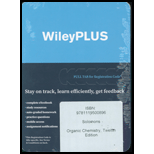
Concept explainers
When toluene is sulfonated (concentrated
Want to see the full answer?
Check out a sample textbook solution
Chapter 15 Solutions
ORGANIC CHEMISTRY-WILEYPLUS ACCESS PKG.
Additional Science Textbook Solutions
Living By Chemistry: First Edition Textbook
Human Biology: Concepts and Current Issues (8th Edition)
Principles of Anatomy and Physiology
Campbell Biology in Focus (2nd Edition)
Chemistry (7th Edition)
Chemistry: An Introduction to General, Organic, and Biological Chemistry (13th Edition)
- Draw all resonance forms of the molecules. Include curved arrow notation. Label major resonance contributor.arrow_forward: Resonance Forms a) Draw all resonance forms of the molecules. Include curved arrow notation. Label major resonance contributor. SO₂ NO3arrow_forward1d. Use Le Chatelier's principle to describe the effect of the following changes on the position of the Haber-Bosch equilibrium: N2(g) + 3H2(g)= 2NH3(9) AH = -92kJ Choose one of the following answers: shift to reactant side, shift to product side or no change and draw the resulting graph. I. Increase the [N2(g)] Effect: H₂ N₂ NH3 II. Decrease the volume of the container. Effect: H₂ N₂2 NH3arrow_forward
- f) The unusual molecule [2.2.2] propellane is pictured. 1) Given the bond length and bond angles in the image, what hybridization scheme best describes the carbons marked by the askerisks? 2) What types of orbitals are used in the bond between the two carbons marked by the askerisks? 3) How does this bond compare to an ordinary carbon-carbon bond (which is usually 1.54 Å long)? CH2 1.60Å H₂C * H₂C CH2 C H2C * C Of H₂ 120°arrow_forwarde) Determine the hybridization and geometry around the indicated carbon atoms. H3C CH3 B HC CH2 A C C C CH3arrow_forwardDon't used Ai solution and hand raitingarrow_forward
- Don't used Ai solutionarrow_forwardDon't used Ai solution and hand raitingarrow_forward75.0 grams of an unknown metal was heated to 95.0°C, it was then placed into 150.0 grams of water at23.1°C, when the metal and water reached thermal equilibrium, the temperature was 27.8°C. Calculatethe specific heat of the metal. (Assume that the specific heat of water is 4.18 J/g °C)arrow_forward

 Organic ChemistryChemistryISBN:9781305580350Author:William H. Brown, Brent L. Iverson, Eric Anslyn, Christopher S. FootePublisher:Cengage Learning
Organic ChemistryChemistryISBN:9781305580350Author:William H. Brown, Brent L. Iverson, Eric Anslyn, Christopher S. FootePublisher:Cengage Learning Organic And Biological ChemistryChemistryISBN:9781305081079Author:STOKER, H. Stephen (howard Stephen)Publisher:Cengage Learning,
Organic And Biological ChemistryChemistryISBN:9781305081079Author:STOKER, H. Stephen (howard Stephen)Publisher:Cengage Learning, General, Organic, and Biological ChemistryChemistryISBN:9781285853918Author:H. Stephen StokerPublisher:Cengage Learning
General, Organic, and Biological ChemistryChemistryISBN:9781285853918Author:H. Stephen StokerPublisher:Cengage Learning



